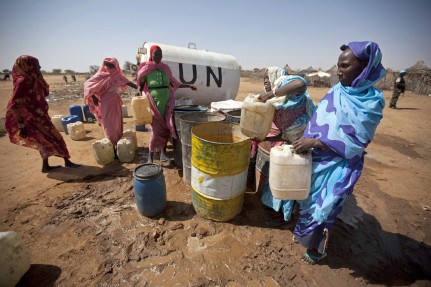
Constituting a majority of the world's poor and at the same time bearing responsibility for half the world's food production and most family health and nutrition needs, women and girls regularly bear the burden of procuring water for multiple household and agricultural uses. When water is not readily accessible, they become a highly vulnerable group. Where access to water is limited, the walk to water is too often accompanied by the threat of attack and violence.
In conflict-affected areas, access to water for any part of the population can become an even more challenging and complex issue. Social fragility, violence, and conflict can be both a cause and a consequence of inequitable and difficult water access. In these settings, access to water for both genders may in part be determined by the underlying circumstances of conflict or instability, which interact with the already complex social, political, economic, and environmental factors affecting resource access. As a key step in supporting long-lasting solutions to persistent vulnerabilities, especially for women and girls, USAID and its partners are seeking to broaden the discussion beyond the issue of vulnerability to attack. The objective is to enhance understanding of the linkages between violence connected to water access and the wider conflict context in which the challenge is embedded.
From dusty stretches of southern Sudan to the densely forested eastern Democratic Republic of the Congo, from the mangrove swamps of southwestern Colombia to the rice paddies of Cambodia, USAID staff have witnessed firsthand the connections between gender, water, and violence in conflict-affected countries. Yet, the results were disappointing when USAID's Office of Conflict Management and Mitigation (CMM), in partnership with the Woodrow Wilson Center's Environmental Change and Security Program, looked for systematic research on these links and guidance on effective responses. Too little research has focused on parsing out and clarifying the connections between the well-established vulnerabilities of women and girls around water collection and the broader contexts in which that violence is situated.
In their ongoing collaboration through the Resources for Peace Project (RFPP), CMM and the Wilson Center are seeking to better understand the underlying causes of that heightened vulnerability and its explicit connections with conflict. "With this new research we hope to establish a broader frame of reference," states Cynthia Brady, a USAID Senior Conflict Advisor at CMM, "in order to help address not only the victimization of women in these environments but to simultaneously improve our understanding of the root causes and consequences of that vulnerability by analyzing the connections with the dynamics of conflict and instability." She further explains that "this includes careful consideration of the range of factors driving risk of attack. The research will also identify what opportunities may exist through water-related programming to reduce the underlying sources of conflict. Our goal is to proactively shore up community resiliency and build stability."
There is an immediate need for focused analysis of the connections between women, water, and conflict to complement the significant, but mostly anecdotal evidence that already exists. In particular, research needs to be done to interpret the very different kinds of potential violence and vulnerability associated with women and water in light of broader conflict dynamics. For example, issues range from the exposure of women as they travel to gather water to direct conflict over access to limited water resources by people of different groups (and its potential to grow into greater inter-group violence). Other issues for closer study include the secondary or tertiary violence stemming from water-related social and demographic disruptions and the possible specific targeting of water-seeking women for political ends.
As an initial step under the RFPP, water and conflict expert Sandra Ruckstuhl of Group W, Inc. has begun to frame the issues and offer guiding questions for addressing the research shortfall. Ruckstuhl finds that "the potential for women's victimization and vulnerability associated with water access is not a phenomenon that can be isolated from the larger context of the system in which it occurs." She suggests: "It would be constructive to move analysis and intellectual discussion beyond the limited focus on the vulnerabilities of women and girls to consider gender dynamics and resilience-building opportunities within the system as a whole."
This preliminary inquiry is aimed at spurring applied policy research to deepen understanding of the connections between water access, gender-based vulnerability, and conflict, and to devise methods for addressing underlying causes. Some initial steps stand out. Staff working at the project-level can better understand the issues by asking how violence around water access connects to wider conflict dynamics. For example, who experiences the risk or reality of harm? Who is the perpetrator of harm, what means do they use, and what are their objectives? What are the issues in the conflict, and how (if at all) do they involve water supply and resources – directly or indirectly? How do gender roles/impacts associated with water access change over time?
Empowering women and girls has become a centerpiece of U.S. diplomatic and development efforts. Employing a holistic view of both gender dynamics and the context of conflict will help ensure that interventions to improve water access are conflict sensitive (minimizing negative impacts and maximizing positive ones). At the same time, interventions should harness opportunities to reduce conflict, build community resilience, and address humanitarian concerns, such as the vulnerability of women and girls. Building on the broad experience and insights from those working in the field and expert analysis, USAID and partners will continue to work on effective and sustainable development approaches to mitigate risk and promote local resiliencies around the intersection of gender, water, and conflict.
C. Brady, G. Dabelko, L. Herzer, J.Patton
For more information, visit:
http://www.usaid.gov/our_work/cross-cutting_programs/conflict/







Comment
Make a general inquiry or suggest an improvement.